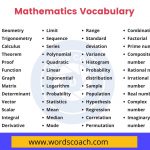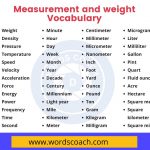Geometry vocabulary list with definitions
Geometry: The branch of mathematics concerned with the properties and relations of points, lines, surfaces, solids, and higher dimensional analogues.
List of Geometry vocabulary
- Angle
- Arc
- Area
- Bisector
- Centroid
- Chord
- Circle
- Circumference
- Collinear
- Complementary Angles
- Cone
- Congruent
- Coordinates
- Cube
- Cylinder
- Decagon
- Diameter
- Dodecagon
- Ellipse
- Equilateral Triangle
- Face
- Geometric Mean
- Hexagon
- Hypotenuse
- Isosceles Triangle
- Line
- Line Segment
- Median
- Midpoint
- Nonagon
- Obtuse Angle
- Octagon
- Parallel Lines
- Parallelogram
- Pentagon
- Perimeter
- Perpendicular Lines
- Pi
- Plane
- Point
- Polygon
- Prism
- Pyramid
- Quadrilateral
- Radius
- Rectangle
- Reflex Angle
- Rhombus
- Right Angle
- Scalene Triangle
- Sector
- Segment
- Sphere
- Square
- Supplementary Angles
- Tangent
- Trapezoid
- Triangle
- Vertex
- Volume
- Adjacent
- Equiangular
- Equidistance
- Equidistant
- Isosceles
- Oval
- Parallel
- Polyhedron
- Scalene
- Spherical
- Spiral
- Trapezium
Geometry vocabulary with definitions and example
Angle: A figure formed by two rays sharing a common endpoint.
- Example: The angle between the hour and minute hands of a clock at 3 o’clock is 90 degrees.
Arc: A segment of a circle’s circumference.
- Example: The arc of a rainbow stretched across the sky after a rain shower.
Area: The measurement of the space inside a two-dimensional figure.
- Example: To find the area of a rectangle, multiply its length by its width.
Bisector: A line or ray that divides an angle into two equal parts.
- Example: The angle bisector of a 90-degree angle divides it into two 45-degree angles.
Centroid: The center point of a triangle where its medians intersect.
- Example: In an equilateral triangle, the centroid is located at the same distance from each vertex.
Chord: A line segment joining two points on a curve, especially in a circle.
- Example: The diameter of a circle is the longest chord that can be drawn within it.
Circle: A closed plane curve consisting of all points at a given distance from a center.
- Example: Earth’s equator forms a circle around the planet when viewed from space.
Circumference: The distance around the edge of a circle.
- Example: To find the circumference of a circle, multiply its diameter by pi (π).
Collinear: Points that lie on the same straight line.
- Example: In a plane, three points are collinear if they can all be connected by a single straight line.
Complementary Angles: Two angles that add up to 90 degrees.
- Example: In a right triangle, the two acute angles are complementary.
Cone: A three-dimensional shape with a circular base tapering to a point.
- Example: An ice cream cone has a conical shape with a circular base.
Congruent: Having the same size and shape.
- Example: Two triangles are congruent if all their corresponding sides and angles are equal.
Coordinates: Ordered pairs (x, y) that locate points on a plane.
- Example: The coordinates (2, 3) represent a point 2 units to the right and 3 units up from the origin.
Cube: A three-dimensional solid with six square faces.
- Example: A Rubik’s cube is a classic example of a three-dimensional cube.
Cylinder: A three-dimensional shape with two parallel circular bases.
- Example: A can of soda is shaped like a cylinder.
Decagon: A polygon with ten sides and ten angles.
- Example: A stop sign is an example of a regular decagon.
Diameter: A straight line passing from side to side through the center of a circle or sphere.
- Example: The diameter of a circle is twice the radius.
Dodecagon: A polygon with twelve sides and twelve angles.
- Example: The shape of a calendar is often a dodecagon.
Ellipse: A regular oval shape, traced by a point moving in a plane so that the sum of its distances from two other points (the foci) is constant.
- Example: The orbits of planets around the sun are elliptical.
Equilateral Triangle: A triangle with all three sides of equal length.
- Example: In an equilateral triangle, all angles measure 60 degrees.
Face: A flat surface of a three-dimensional solid.
- Example: A cube has six faces, each of which is a square.
Geometric Mean: The average value of a set of numbers or quantities, calculated by taking the nth root of their product.
- Example: The geometric mean is useful for finding average rates of change over time.
Hexagon: A polygon with six sides and six angles.
- Example: A honeycomb cell often has the shape of a regular hexagon.
Hypotenuse: The longest side of a right triangle, opposite the right angle.
- Example: In a 3-4-5 triangle, the hypotenuse is 5 units long.
Isosceles Triangle: A triangle with at least two sides of equal length.
- Example: In triangle ABC, AB = AC, making it an isosceles triangle.
Line: A straight one-dimensional figure extending infinitely in both directions.
- Example: The equator is an imaginary line around the middle of Earth.
Line Segment: A part of a line with two endpoints.
- Example: The line segment AB connects points A and B.
Median: A line segment joining a vertex of a triangle to the midpoint of the opposite side.
- Example: In triangle ABC, the median from vertex A to side BC divides BC into two equal segments.
Midpoint: The point that divides a line segment into two equal parts.
- Example: The midpoint of line segment AB is exactly halfway between points A and B.
Nonagon: A polygon with nine sides and nine angles.
- Example: A stop sign is a regular nonagon.
Obtuse Angle: An angle greater than 90 degrees but less than 180 degrees.
- Example: In triangle XYZ, angle Y is obtuse because it measures 120 degrees.
Octagon: A polygon with eight sides and eight angles.
- Example: The shape of a stop sign is an octagon.
Parallel Lines: Lines that are always the same distance apart and never meet.
- Example: Railroad tracks are an example of parallel lines.
Parallelogram: A four-sided figure with opposite sides parallel and equal in length.
- Example: A square is a special type of parallelogram with all sides equal and all angles right angles.
Pentagon: A polygon with five sides and five angles.
- Example: The Pentagon building in Washington D.C. is shaped like a regular pentagon.
Perimeter: The distance around the outside of a shape.
- Example: To find the perimeter of a rectangle, add together all its sides.
Perpendicular Lines: Lines that intersect at right angles.
- Example: The sides of a square are perpendicular to each other.
Pi: A mathematical constant approximately equal to 3.14159, representing the ratio of the circumference of a circle to its diameter.
- Example: The value of pi is essential in calculating the area and circumference of circles.
Plane: A flat, two-dimensional surface that extends infinitely in all directions.
- Example: A sheet of paper can be thought of as a plane.
Point: An exact location or position in space, represented by a dot.
- Example: Point A is located at coordinates (3, 4) on the Cartesian plane.
Polygon: A closed plane figure with straight sides.
- Example: A triangle, square, and pentagon are examples of polygons.
Prism: A three-dimensional figure with two identical polygonal bases and other faces that are parallelograms.
- Example: A rectangular prism, like a box, has two rectangular bases and four rectangular faces.
Pyramid: A polyhedron with a polygonal base and triangular faces that meet at a common vertex.
- Example: The Great Pyramid of Giza in Egypt is a famous example of a pyramid.
Quadrilateral: A polygon with four sides and four angles.
- Example: A square, rectangle, and rhombus are all types of quadrilaterals.
Radius: The distance from the center of a circle or sphere to any point on its circumference or surface.
- Example: The radius of a circle is half the length of its diameter.
Rectangle: A four-sided figure with opposite sides of equal length and all angles right angles.
- Example: A book is often shaped like a rectangle.
Reflex Angle: An angle greater than 180 degrees but less than 360 degrees.
- Example: In geometry, a reflex angle is considered obtuse.
Rhombus: A parallelogram with all sides equal in length.
- Example: A kite is a type of rhombus where two sides are equal in length.
Right Angle: An angle that measures exactly 90 degrees.
- Example: The corners of a square are all right angles.
Scalene Triangle: A triangle with all sides of different lengths.
- Example: Triangle ABC is scalene because AB ≠ AC ≠ BC.
Sector: The region bounded by two radii of a circle and the arc between them.
- Example: The pizza slice represents a sector of the circular pizza.
Segment: A part of a circle bounded by a chord and the arc subtended by the chord.
- Example: In circle O, segment AB is the region between chord AB and arc AB.
Sphere: A three-dimensional geometric shape resembling a round ball.
- Example: Earth is approximately a sphere.
Square: A four-sided polygon with all sides equal in length and all angles right angles.
- Example: A chessboard has squares as its basic units.
Supplementary Angles: Two angles whose measures sum up to 180 degrees.
- Example: Angles measuring 120 degrees and 60 degrees are supplementary.
Tangent: A line that touches a curve at exactly one point without crossing through it.
- Example: A tangent to a circle touches the circle at only one point.
Trapezoid: A quadrilateral with at least one pair of parallel sides.
- Example: In trapezoid ABCD, AB || CD and AD ≠ BC.
Triangle: A three-sided polygon.
- Example: Triangle DEF has sides DE, EF, and FD.
Vertex: A point where two or more straight lines meet.
- Example: The corners of a square are its vertices.
Volume: The amount of space occupied by a three-dimensional object.
- Example: The volume of a cube can be calculated using V = s³, where s is the length of a side.
Adjacent: Next to or adjoining something else.
- Example: In geometry, angles that share a common vertex and a common side are adjacent angles.
Equiangular: A polygon with all interior angles equal.
- Example: An equiangular triangle has angles of 60 degrees each.
Equidistance: Equal distance from a point, line, or plane.
- Example: Points on the circumference of a circle are equidistant from the center.
Equidistant: At equal distances.
- Example: The points A, B, and C are equidistant from point D.
Isosceles: A triangle with at least two sides of equal length.
- Example: Triangle XYZ is isosceles because XY = XZ.
Oval: An elongated, rounded shape like that of an egg or an ellipse.
- Example: An oval-shaped mirror hangs on the wall.
Parallel: Lines that are always the same distance apart and never meet.
- Example: Railroad tracks are parallel lines.
Polyhedron: A solid figure with many plane faces, typically more than four.
- Example: A cube and a pyramid are examples of polyhedrons.
Scalene: A triangle with all sides of different lengths.
- Example: Triangle PQR is scalene because PQ ≠ PR ≠ QR.
Spherical: Shaped like a sphere.
- Example: A basketball is spherical in shape.
Spiral: A curve that starts from a point and moves away from that point while getting progressively farther away as it revolves around an axis.
- Example: The shell of a snail is shaped like a spiral.
Trapezium: A quadrilateral with no parallel sides (in some countries) or with exactly one pair of parallel sides (in other countries).
- Example: In trapezium ABCD, AB || CD.





